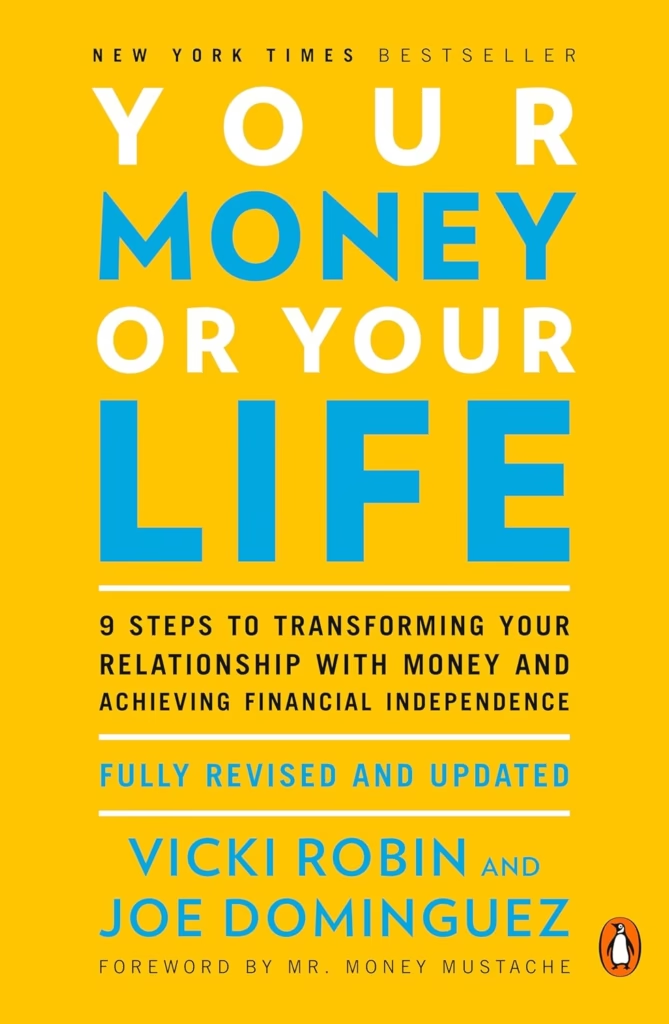Your cart is currently empty!
Your Money or Your Life – 9 Powerful Steps to Transform Your Financial Future

Introduction – Your Money or Your Life
Your Money or Your Life by Vicki Robin and Joe Dominguez is a revolutionary personal finance book that redefines our relationship with money. First published in 1992 and updated over the years, the book offers more than just financial advice—it presents a life-transforming philosophy that integrates money management with mindfulness, personal values, and purposeful living.
This blog post dives deep into the key insights and lessons from Your Money or Your Life, providing over 2000 words of actionable takeaways to help you shift from a consumption-driven lifestyle to one rooted in financial independence and intentional living.
Table of Contents

The Core Philosophy
At its heart, Your Money or Your Life challenges readers to ask a fundamental question: Are you making a living or making a dying? The authors argue that we trade our most precious resource—life energy—for money, and therefore, we must ensure that our money aligns with our values and life purpose.
Key Questions:
- How much are you really earning per hour?
- Is the way you spend your money bringing fulfillment?
- What is enough for you?
The Nine-Step Program to Financial Independence
The authors present a structured Nine-Step Program that leads to financial independence and a life of purpose. Here’s a breakdown of each step:
Step 1: Making Peace with the Past
Calculate how much money you’ve earned in your lifetime.
This exercise creates awareness of your financial history and compels you to reflect on what you have to show for it.
Key Takeaway: Your lifetime earnings represent the sum of your working life. Assess how much of it translated into lasting value.
Step 2: Being in the Present—Tracking Your Life Energy
Calculate your real hourly wage.
This means accounting for all job-related expenses (commute, wardrobe, stress, meals, etc.) and subtracting them from your salary. Then, divide your net income by the actual hours spent on work—including overtime and recovery.
Key Takeaway: Your job costs more than you think. Know your true hourly wage to make informed financial decisions.
Step 3: Where Is It All Going?
Track every cent you spend.
Categorize all your expenses monthly and match them to the hours of life energy they cost.
Key Takeaway: Tracking creates mindfulness. When you link money to life energy, spending decisions become more intentional.
Step 4: Three Questions That Will Transform Your Life
Ask these for each expense:
- Did I receive fulfillment in proportion to life energy spent?
- Is this expenditure in alignment with my values and purpose?
- How might I change this expense going forward?
Key Takeaway: Use your values as a compass for spending, rather than peer pressure or consumer culture.
Step 5: Making Life Energy Visible
Create a monthly wall chart showing income and expenses.
This helps visualize progress and instills discipline. The goal is to achieve clarity and eventually close the gap between earning and spending.
Key Takeaway: Visual representation motivates change and reinforces accountability.
Step 6: Valuing Your Life Energy—Minimizing Spending
Learn to spend less without sacrifice.
This involves rethinking needs vs. wants, seeking fulfillment in non-material ways, and cultivating frugality as a joyful lifestyle.
Key Takeaway: Financial independence is accelerated by conscious, values-based spending.
Step 7: Valuing Your Life Energy—Maximizing Income
Increase income with purpose.
Unlike mainstream advice that emphasizes climbing the corporate ladder, Robin and Dominguez suggest aligning income generation with passion and sustainability.
Key Takeaway: More income can be beneficial if it doesn’t compromise your life energy and values.
Step 8: Capital and the Crossover Point
Reach the Crossover Point—where investment income equals expenses.
This is the moment you no longer need to work for money. You achieve true financial independence.
Key Takeaway: Focus on building capital and reducing expenses to reach financial independence sooner.
Step 9: Managing Your Finances
Continue managing your capital wisely.
Shift from active earning to passive income through safe investments. The book emphasizes simplicity and low-risk financial tools.
Key Takeaway: Financial independence is a journey, not a destination. Maintain it through conscious financial stewardship.
Life Energy: A Revolutionary Concept
One of the most powerful ideas in the book is that money represents life energy. Every dollar you earn costs you time, effort, and vitality. When you understand this, frivolous spending takes on a new weight.
Applications:
- Before every purchase, ask: Is this worth the life energy it costs?
- Recognize that regaining your time is more valuable than accumulating more money.
Key Takeaway: Shifting your mindset from money-as-currency to money-as-life-energy changes your financial behavior fundamentally.
Conscious Consumption vs. Consumerism
Robin and Dominguez critique modern consumerism, which equates spending with happiness. They advocate for conscious consumption—making spending decisions based on needs, values, and genuine satisfaction.
Tips for Conscious Consumption:
- Delay gratification—wait 24 hours before buying non-essentials
- Borrow, barter, or buy used
- Focus on experiences over possessions
Key Takeaway: Detach self-worth from material possessions to gain control over your money and your life.
Reframing Work and Income
The book invites readers to reevaluate the role of work. Work should not be the centerpiece of life, but a means to support a fulfilling lifestyle. By minimizing spending and maximizing meaningful income, one can reduce dependency on full-time work.
Key Insight: True wealth is not having more money, but needing less of it.
The Fulfillment Curve
The Fulfillment Curve illustrates the relationship between spending and happiness. Up to a point, spending improves quality of life (e.g., food, shelter, health). Beyond that point, more spending leads to diminishing—and eventually negative—returns.
Key Takeaway: Identify your “Enough Point.” Don’t chase excess that leads to clutter, stress, and dissatisfaction.
Sustainability and Financial Independence
A recurring theme in the book is sustainability—not just financially, but environmentally and personally. Living intentionally reduces your carbon footprint, reliance on consumer goods, and stress levels.
Key Takeaway: Frugality and sustainability go hand-in-hand. Financial independence supports a healthier planet and a balanced lifestyle.
Challenges and Criticisms
While many readers have embraced the book’s philosophy, it may not be suited for everyone. Critics argue that:
- The system requires intense discipline
- Tracking every penny can feel overwhelming
- The approach may seem extreme in high-cost living areas
Still, the overall message—intentional living over blind consumption—resonates with readers from diverse backgrounds.
Modern-Day Relevance
In an era marked by inflation, job insecurity, and social media-driven consumerism, the principles of Your Money or Your Life are more relevant than ever. The FIRE (Financial Independence, Retire Early) movement has adopted many of the book’s principles, further proving its lasting impact.
Relevance Today:
- Emphasis on remote work and lifestyle flexibility
- Growing interest in minimalism
- Desire for work-life balance
Conclusion
Your Money or Your Life isn’t just about saving money—it’s about reclaiming your time, purpose, and freedom. By recognizing that money is a representation of your life energy, you can transform your financial choices and, ultimately, your life.
Whether you’re striving for financial independence, seeking a more intentional lifestyle, or just want to escape the rat race, this book offers a comprehensive and compassionate roadmap.
Ready to redefine your relationship with money? Start by asking: Is this worth my life energy?
And remember: Take is Yours.
You can get full book copy here!!

- Unleashing the Future: Top 10 Healthcare AI Tools Revolutionizing Patient Care in 2025
- Ultimate Guide to Sustainable Travel Tips and Eco Friendly Travel 2025: Embrace Conscious Travel Trends & Green Travel Destinations
- Ultimate AI Revolution Uncovered: How Artificial Intelligence is Impacting Daily Life Globally in 2025
- Ultimate Digital Nomad Destinations 2025: Discover Where the World’s Best Remote Workers Are Heading Next
- The Future of Remote Work 2025 Trends Shaping How We Work

Leave a Reply
You must be logged in to post a comment.